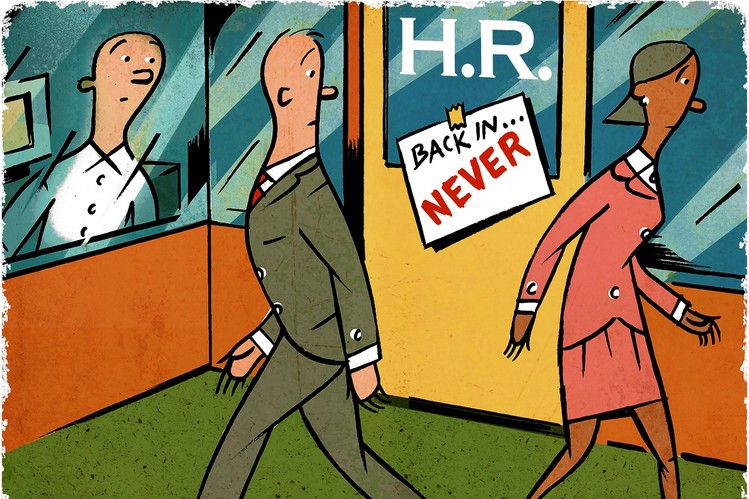BambooHR, Zenefits, Paycor Perform. What do all these companies, and their websites, have in common? They’re the modern version of a human resources department, a trend that might continue to grow as business documents get switched over to digital platforms for storage.
BambooHR, for example, was built for small and medium-sized businesses to modernize and make their human resources department more efficient, according to the company website. What do sites like this offer a body shop? A move away from traditional filing cabinets, an online HR information system, and database record. Paycor Perform is a similar company and offers businesses payroll and taxes; time and attendance, recruiting and onboarding, and record keeping.
So, online or software-based HR software systems not only exist, but are also rather prevalent. There are also benefits to modernizing a shop’s HR department, like making it easier to retain information for the shop without using up a lot of space and saving the shop money, says Jim Webber, an experienced human resources consultant, who has worked as an HR consultant for 25 year and used to be an employment lawyer.
Jaime Klein, founder and president of Inspire Human Resources, says the move to go digital and to a cloud-based HR department is progressive. Klein has worked as a workplace culture expert and HR business partner since 1994. Before founding Inspire Human Resources, Klein led human resources initiatives at American Express and grew the HR department at Commerce One’s New York office.
Webber says traditional human resource process and practices come with their own challenges. Sites like Zenefits, BambooHR and Paycor Perform, offer businesses a more efficient way to access human resource information. Webber and Klein outline four shop processes that might be causing stress and how going to the cloud will fix them.
Headache No. 1: Lack of storage
Webber says one of the most common frustrations with human resources is the amount of storage required to house all of the paperwork for all employees. A modernized human resources department makes it simpler to retain information in a user-friendly format. Since the information is stored in the cloud or an online database, the company’s employment records can be stored without taking up any physical space in the shop.
“Whenever you can automate a process, it frees people to work on time-building relationships,” Klein says.
Some larger companies believe that the more administrative processes can be handled via a call center environment or self-serve where employees go online with a password and do a lot of their own payroll, deductions and various information updates.
Moving administrative processes online helps free up the employee, specifically an HR employee, to focus on aspects of the business like culture, giving people direct feedback, helping people be strong performers and making sure people are in the right kind of jobs, Klein says.
Headache No. 2: Complications as growth occurs
There is no set way to know when a shop will be ready for its human resources department to go paperless, Webber says. But, as a general rule of thumb, he says that, typically, a smaller company of roughly 10 people could conceivably keep track of everything HR-related through a traditional HR in-house department.
As the company grows, however, it might be easier to consolidate that information to an online HR portal.
“But, if you’re using a modern HR department when you’re a small company, it could make it easier to apply it to a large group as you grow and already have that program established,” Webber says.
While Webber isn’t certain of the exact amounts of money that a shop owner can save through digitizing some human resources roles, the whole process can save the shop money.
For example, filing reports—such as for OSHA and equal employment opportunity (EEO) policies—online could save a business time. Now, the reports could be available at the touch of a button.
Then, the process eliminates some payroll costs, filing duties and some hard fixture costs as to what is in the building, he says.
Klein says that moving HR administrative processes to the cloud also enables managers to focus on hiring new talent and making sure the existing workforce is thriving and comfortably placed in their roles. Especially nowadays, she says, a lot of businesses are focusing efforts on hosting all-company meetings to talk about workplace inclusion, ethics or sexual-harassment.
Headache No. 3: Initial training needs
One challenge, Webber says, is finding someone who has experience with IT or technology to implement the system. While some companies that offer modern HR features offer installation and training themselves, Webber stresses that a shop needs a qualified person to help the staff learn the process.
“People need a learning time to make mistakes and everything,” Webber says.
And, a shop operator needs to remember that some employees who have worked at the business for a long time might have a harder time accepting a switch from traditional HR methods to digital ones.
“I think it’s a challenge to not take shortcuts when switching to a new process,” Webber says.
Headache No. 4: No security measures in place
A body shop owner should take into account that paper-based HR practices pose security risks because that information might not be stored securely or confidentially. It can also be easily misplaced.
While the No. 1 question people ask about cloud-based HR systems is regarding security issues, Klein says that, at this point, with the process of moving HR to the cloud, it’s acceptable in very strategic HR functions that that information does live in the cloud.
However, that doesn’t mean you shouldn’t put safeguards in place to avoid any potential security breaches, as uncommon as they may be.
“I do think companies need to always be evaluating their security and privacy issues to ensure it is a better and better program so that employees have that safeguard,” she says.
Passwords, for example, need to be kept secure, and employees need to be protected from the possibility of identity theft.
Switching from an older HR process to a new one makes keeping the old processes tricky. For example, if paychecks were traditionally mailed out to employees, there might be a system and processing wait to switch that over to direct deposits for the staff, Webber explains.
When members of the HR department have to communicate with an employee, there should be an emergency contact list saved somewhere so it is easily accessible during the process.
For more updates: Like us on Facebook and follow us on Twitter & Instagram





































